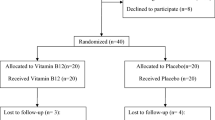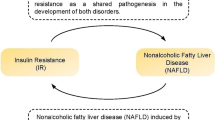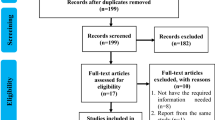Abstract
Background/Objectives
Non-alcoholic fatty liver disease (NAFLD) is growing in prevalence globally and no definitive evidence for any approved pharmacological approaches for patients with NAFLD has been found yet. This study was aimed to assess the clinical effects of flaxseed and hesperidin in patients with NAFLD.
Subjects/methods
In this randomized, controlled, clinical trial, one hundred eligible patients with NAFLD were enrolled and randomly assigned to four dietary intervention groups including lifestyle modification program (control), lifestyle modification program with 30 g whole flaxseed powder, lifestyle modification program with 1 g hesperidin supplementation, and lifestyle modification program with combination of 30 g flaxseed and 1 g hesperidin (flax-hes) for 12 weeks. The changes in anthropometric parameters, metabolic profiles of glucose and lipids, inflammatory biomarkers and hepatic steatosis and fibrosis were evaluated.
Results
After the 12-week dietary interventions, significant reductions in body mass index, glucose hemostasis parameters and hepatic steatosis were observed in all groups. Repeated measures analysis of variance revealed a significant effect for time relative to almost all paraclinical parameters. Post hoc analysis with Bonferroni correction revealed that the three intervention groups experienced significant decreases in plasma levels of alanine aminotransferase, indices of insulin resistance and insulin sensitivity, fasting glucose and fatty liver index compared to control (p < 0.008).
Conclusions
In conclusion, our study confirmed that hesperidin and flaxseed supplementation improved glucose and lipid metabolism, while reduced inflammation and hepatic steatosis (controlled attenuation parameter) in NAFLD patients. The synergistic effects of their combination were observed on plasma glucose concentration and HOMA-IR.
This is a preview of subscription content, access via your institution
Access options
Subscribe to this journal
Receive 12 print issues and online access
$259.00 per year
only $21.58 per issue
Buy this article
- Purchase on Springer Link
- Instant access to full article PDF
Prices may be subject to local taxes which are calculated during checkout



Similar content being viewed by others
References
Liver EAFTSOT, Diabetes EAftSo. EASL-EASD-EASO Clinical Practice Guidelines for the management of non-alcoholic fatty liver disease. Obes Facts. 2016;9:65–90.
Vernon G, Baranova A, Younossi Z. Systematic review: the epidemiology and natural history of non‐alcoholic fatty liver disease and non‐alcoholic steatohepatitis in adults. Aliment Pharmacol Ther. 2011;34:274–85.
Adams LA, Anstee QM, Tilg H, Targher G. Non-alcoholic fatty liver disease and its relationship with cardiovascular disease and other extrahepatic diseases. Gut. 2017;66:1138–53.
Younossi ZM, Ratziu V, Loomba R, Rinella M, Anstee QM, Goodman Z, et al. Obeticholic acid for the treatment of non-alcoholic steatohepatitis: interim analysis from a multicentre, randomised, placebo-controlled phase 3 trial. Lancet. 2019;394:2184–96.
Watanabe M, Tozzi R, Risi R, Tuccinardi D, Mariani S, Basciani S, et al. Beneficial effects of the ketogenic diet on nonalcoholic fatty liver disease: a comprehensive review of the literature. Obes Rev. 2020;21:e13024.
Laursen TL, Hagemann CA, Wei C, Kazankov K, Thomsen KL, Knop FK, et al. Bariatric surgery in patients with non-alcoholic fatty liver disease-from pathophysiology to clinical effects. World J Hepatol. 2019;11:138.
Bao L, Yin J, Gao W, Wang Q, Yao W, Gao X. A long‐acting FGF21 alleviates hepatic steatosis and inflammation in a mouse model of non‐alcoholic steatohepatitis partly through an FGF21‐adiponectin‐IL17A pathway. Br J Pharmacol. 2018;175:3379–93.
Sattar N, Forrest E, Preiss D. Non-alcoholic fatty liver disease. BMJ. 2014;349:24–8.
Thoma C, Day CP, Trenell MI. Lifestyle interventions for the treatment of non-alcoholic fatty liver disease in adults: a systematic review. J Hepatol. 2012;56:255–66.
Mazzella N, Ricciardi LM, Mazzotti A, Marchesini G. The role of medications for the management of patients with NAFLD. Clin Liver Dis. 2014;18:73–89.
Asrih M, Jornayvaz FR. Diets and nonalcoholic fatty liver disease: the good and the bad. Clin Nutr. 2014;33:186–90.
Dudekula A, Rachakonda V, Shaik B, Behari J. Weight loss in nonalcoholic Fatty liver disease patients in an ambulatory care setting is largely unsuccessful but correlates with frequency of clinic visits. PLoS ONE. 2014;9:e111808.
Greenway F. Physiological adaptations to weight loss and factors favouring weight regain. Int J Obes. 2015;39:1188.
Pugh CJ, Sprung V, Jones H, Richardson P, Shojaee-Moradie F, Umpleby AM, et al. Exercise-induced improvements in liver fat and endothelial function are not sustained 12 months following cessation of exercise supervision in nonalcoholic fatty liver disease. Int J Obes. 2016;40:1927.
Mokhtari Z, Poustchi H, Eslamparast T, Hekmatdoost A. Egg consumption and risk of non-alcoholic fatty liver disease. World J Hepatol. 2017;9:503–9.
Noori M, Jafari B, Hekmatdoost A. Pomegranate juice prevents development of non-alcoholic fatty liver disease in rats by attenuating oxidative stress and inflammation. J Sci Food Agric. 2017;97:2327–32.
Rahimlou M, Yari Z, Hekmatdoost A, Alavian SM, Keshavarz SA. Ginger supplementation in nonalcoholic fatty liver disease: a randomized, double-blind, placebo-controlled pilot study. Hepat Mon. 2016;16:e34897.
Emamat H, Foroughi F, Eini-Zinab H, Taghizadeh M, Rismanchi M, Hekmatdoost A. The effects of onion consumption on treatment of metabolic, histologic, and inflammatory features of nonalcoholic fatty liver disease. J Diabetes Metab Disord. 2015;15:25.
Yari Z, Rahimlou M, Eslamparast T, Ebrahimi-Daryani N, Poustchi H, Hekmatdoost A. Flaxseed supplementation in non-alcoholic fatty liver disease: a pilot randomized, open labeled, controlled study. Int J Food Sci Nutr. 2016;67:461–9.
Morris DH. Flax: a health and nutrition primer. Flax Council of Canada; Winnipeg, MB, Canada, 2007.
Daun JK, Barthet VJ, Chornick TL, Duguid S. Structure, composition, and variety development of flaxseed. Flaxseed in human nutrition: AOCS Publishing; Champaign, Illinois, 2003. p. 6–45.
Hassanali Z, Ametaj B, Field C, Proctor S, Vine D. Dietary supplementation of n‐3 PUFA reduces weight gain and improves postprandial lipaemia and the associated inflammatory response in the obese JCR: LA‐cp rat. Diabetes Obes Metab. 2010;12:139–47.
Tai CC, Ding ST. N-3 polyunsaturated fatty acids regulate lipid metabolism through several inflammation mediators: mechanisms and implications for obesity prevention. J Nutr Biochem. 2010;21:357–63.
Yari Z, Rahimlou M, Poustchi H, Hekmatdoost A. Flaxseed supplementation in metabolic syndrome management: a pilot randomized, open‐labeled, controlled study. Phytother Res. 2016;30:1339–44.
Rhee Y, Brunt A. Flaxseed supplementation improved insulin resistance in obese glucose intolerant people: a randomized crossover design. Nutr J. 2011;10:44.
Edel AL, Rodriguez-Leyva D, Maddaford TG, Caligiuri SP, Austria JA, Weighell W, et al. Dietary flaxseed independently lowers circulating cholesterol and lowers it beyond the effects of cholesterol-lowering medications alone in patients with peripheral artery disease–4. J Nutr. 2015;145:749–57.
Mohammadi‐Sartang M, Mazloom Z, Raeisi‐Dehkordi H, Barati‐Boldaji R, Bellissimo N, Totosy, et al. The effect of flaxseed supplementation on body weight and body composition: a systematic review and meta‐analysis of 45 randomized placebo‐controlled trials. Obes Rev. 2017;18:1096–107.
Yari Z, Rahimlou M, Hekmatdoost A. Flaxseed supplementation improves anthropometric measurements, metabolic, and inflammatory biomarkers in overweight and obese adults. Int J Vitamin Nutr Res. 2019;1–8.
Manach C, Scalbert A, Morand C, Rémésy C, Jiménez L. Polyphenols: food sources and bioavailability. Am J Clin Nutr. 2004;79:727–47.
Rizza S, Muniyappa R, Iantorno M, Kim J-A, Chen H, Pullikotil P, et al. Citrus polyphenol hesperidin stimulates production of nitric oxide in endothelial cells while improving endothelial function and reducing inflammatory markers in patients with metabolic syndrome. J Clin Endocrinol Metab. 2011;96:E782–E92.
Parhiz H, Roohbakhsh A, Soltani F, Rezaee R, Iranshahi M. Antioxidant and anti‐inflammatory properties of the citrus flavonoids hesperidin and hesperetin: an updated review of their molecular mechanisms and experimental models. Phytother Res. 2015;29:323–31.
De Ledinghen V, Vergniol J. Transient elastography (fibroscan). Gastroenterol Clin Biol. 2008;32:58–67.
Initiative NOE, Heart N, Lung, Institute B, Obesity NAAftSo, Identification EPot, et al. The practical guide: identification, evaluation, and treatment of overweight and obesity in adults: The Institute; Bethesda, Maryland, 2000.
Kelishadi R, Rabiei K, Khosravi A, Famouri F, Sadeghi M, Rouhafza H, et al. Assessment of physical activity of adolescents in Isfahan. J Shahrekord Univ Med Sci. 2001;3:55–66.
Friedewald WT, Levy RI, Fredrickson DS. Estimation of the concentration of low-density lipoprotein cholesterol in plasma, without use of the preparative ultracentrifuge. Clin Chem. 1972;18:499–502.
Simental-Mendía LE, Rodríguez-Morán M, Guerrero-Romero F. The product of fasting glucose and triglycerides as surrogate for identifying insulin resistance in apparently healthy subjects. Metab Syndr Relat Disord. 2008;6:299–304.
Katz A, Nambi SS, Mather K, Baron AD, Follmann DA, Sullivan G, et al. Quantitative insulin sensitivity check index: a simple, accurate method for assessing insulin sensitivity in humans. J Clin Endocrinol Metab. 2000;85:2402–10.
Bedogni G, Bellentani S, Miglioli L, Masutti F, Passalacqua M, Castiglione A, et al. The Fatty Liver Index: a simple and accurate predictor of hepatic steatosis in the general population. BMC Gastroenterol. 2006;6:33.
Ruffillo G, Fassio E, Alvarez E, Landeira G, Longo C, Domínguez N, et al. Comparison of NAFLD fibrosis score and BARD score in predicting fibrosis in nonalcoholic fatty liver disease. J Hepatol. 2011;54:160–3.
Torkan M, Entezari MH, Siavash M. Effect of flaxseed on blood lipid level in hyperlipidemic patients. Rev Recent Clin Trials. 2015;10:61–7.
Patade A, Devareddy L, Lucas EA, Korlagunta K, Daggy BP, Arjmandi BH. Flaxseed reduces total and LDL cholesterol concentrations in Native American postmenopausal women. J Women’s Health. 2002;17:355–66. 2008
Xu J, Yang W, Deng Q, Huang Q, Huang F. Flaxseed oil and α-lipoic acid combination reduces atherosclerosis risk factors in rats fed a high-fat diet. Lipids Health Dis. 2012;11:148.
Di Y, Jones J, Mansell K, Whiting S, Fowler S, Thorpe L, et al. Influence of flaxseed lignan supplementation to older adults on biochemical and functional outcome measures of inflammation. J Am Coll Nutr. 2017;36:646–53.
Felmlee MA, Woo G, Simko E, Krol ES, Muir AD, Alcorn J. Effects of the flaxseed lignans secoisolariciresinol diglucoside and its aglycone on serum and hepatic lipids in hyperlipidaemic rats. Br J Nutr. 2009;102:361–9.
Salden BN, Troost FJ, de Groot E, Stevens YR, Garcés-Rimón M, Possemiers S, et al. Randomized clinical trial on the efficacy of hesperidin 2S on validated cardiovascular biomarkers in healthy overweight individuals. Am J Clin Nutr. 2016;104:1523–33.
Mohammadi M, Ramezani-Jolfaie N, Lorzadeh E, Khoshbakht Y, Salehi-Abargouei A. Hesperidin, a major flavonoid in orange juice, might not affect lipid profile and blood pressure: a systematic review and meta-analysis of randomized controlled clinical trials. Phytother Res. 2019;33:534–45.
Jung UJ, Lee M-K, Park YB, Kang MA, Choi M-S. Effect of citrus flavonoids on lipid metabolism and glucose-regulating enzyme mRNA levels in type-2 diabetic mice. Int J Biochem cell Biol. 2006;38:1134–45.
Lawrenz J, Herndon B, Kamal A, Mehrer A, Dim DC, Baidoo C, et al. Dietary flaxseed oil protects against bleomycin-induced pulmonary fibrosis in rats. Pulmonary medicine. 2012;2012:457031.
Xu J, Gao H, Song L, Yang W, Chen C, Deng Q, et al. Flaxseed oil and alpha-lipoic acid combination ameliorates hepatic oxidative stress and lipid accumulation in comparison to lard. Lipids Health Dis. 2013;12:58.
Dentin R, Benhamed F, Pégorier J-P, Foufelle F, Viollet B, Vaulont S, et al. Polyunsaturated fatty acids suppress glycolytic and lipogenic genes through the inhibition of ChREBP nuclear protein translocation. The. J Clin Investig. 2005;115:2843–54.
Marx N, Duez H, Fruchart J-C, Staels B. Peroxisome proliferator-activated receptors and atherogenesis: regulators of gene expression in vascular cells. Circ Res. 2004;94:1168–78.
Jump DB. N-3 polyunsaturated fatty acid regulation of hepatic gene transcription. Curr Opin Lipidol. 2008;19:242.
Hutchins AM, Brown BD, Cunnane SC, Domitrovich SG, Adams ER, Bobowiec CE. Daily flaxseed consumption improves glycemic control in obese men and women with pre-diabetes: a randomized study. Nutr Res. 2013;33:367–75.
Ghanim H, Sia CL, Upadhyay M, Korzeniewski K, Viswanathan P, Abuaysheh S, et al. Orange juice neutralizes the proinflammatory effect of a high-fat, high-carbohydrate meal and prevents endotoxin increase and Toll-like receptor expression. Am J Clin Nutr. 2010;91:940–9.
Hallund J, Tetens I, Bügel S, Tholstrup T, Bruun JM. The effect of a lignan complex isolated from flaxseed on inflammation markers in healthy postmenopausal women. Nutr Metab Cardiovas Dis. 2008;18:497–502.
Nasri K, Hantoushzadeh S, Aghadavod E, Taghizadeh M, Asemi Z. The effects of omega-3 fatty acids supplementation on gene expression involved in the insulin and lipid signaling pathway in patients with polycystic ovary syndrome. Horm Metab Res. 2017;49:446–51.
Zhao Y, Joshi-Barve S, Barve S, Chen LH. Eicosapentaenoic acid prevents LPS-induced TNF-α expression by preventing NF-κB activation. J Am Coll Nutr. 2004;23:71–8.
Malekzadeh R, Poustchi H. Fibroscan for assessing liver fibrosis: an acceptable alternative for liver biopsy: Fibroscan: an acceptable alternative for liver biopsy. Hepat Mon. 2011;11:157.
Acknowledgements
We acknowledge all patients who accepted to participate in this study.
Author information
Authors and Affiliations
Contributions
ZY was responsible for conceptualization and designing the study, recruiting and following patients, writing the manuscript. MC was responsible for conceptualization and designing the study, providing supplements and commercial kits, reviewing the manuscript. SMA was responsible forassessing liver steatosis using a transient elastography (FibroScan). MH was responsible for biochemical evaluations in samples collected, using the relative kits, according to the manufacturer’s instructions. HEZ was responsible for statistical analyzing. AH was responsible for conceptualization and designing the study, project administration, writing, review and editing the manuscript.
Corresponding authors
Ethics declarations
Conflict of interest
The authors declare that they have no conflict of interest.
Additional information
Publisher’s note Springer Nature remains neutral with regard to jurisdictional claims in published maps and institutional affiliations.
Supplementary information
Rights and permissions
About this article
Cite this article
Yari, Z., Cheraghpour, M., Alavian, S.M. et al. The efficacy of flaxseed and hesperidin on non-alcoholic fatty liver disease: an open-labeled randomized controlled trial. Eur J Clin Nutr 75, 99–111 (2021). https://doi.org/10.1038/s41430-020-0679-3
Received:
Revised:
Accepted:
Published:
Issue Date:
DOI: https://doi.org/10.1038/s41430-020-0679-3
This article is cited by
-
Natural compounds proposed for the management of non-alcoholic fatty liver disease
Natural Products and Bioprospecting (2024)
-
Fatty liver index (FLI): more than a marker of hepatic steatosis
Journal of Physiology and Biochemistry (2024)
-
The Role of Nutrition on Meta-inflammation: Insights and Potential Targets in Communicable and Chronic Disease Management
Current Obesity Reports (2022)



